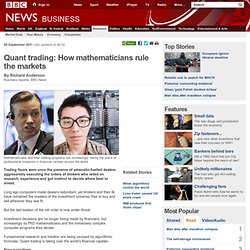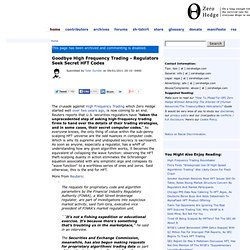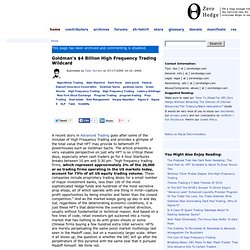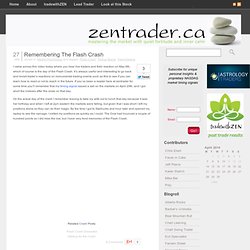

High-frequency trading. High-Frequency Trading Is Evil, Right? Not So, Says the BIS - The Source. By Eva Szalay Everyone knows that high-frequency traders are the evil geniuses of the foreign-exchange market, right?

They damage liquidity, swoop aggressively on tiny price errors, curdle milk with their oh-so-fancy computers and generally make the market harder for everyone to navigate. That’s what their detractors say. But the Bank for International Settlements, no less, doesn’t seem to agree. A new study by the BIS, based on research from officials at some 14 central banks, says that high-frequency traders (or HFTs in market speak) smooth out currency movements, help spread liquidity around this fragmented market and help to make trading cheaper for everyone.
HFTs do raise big questions, the BIS said. Still, why do we only ever hear bad things about them? Exclusive: Regulators seek trading secrets. Algorithmic Trading is Not High Frequency Trading. September 13, 2011 It’s not every day I come across a widely-shared article whose first sentence is factually incorrect, but a 9/9/11 story in Computerworld UK, “Algorithmic stock trading rapidly replacing humans, warns government paper”, is just such a creature. Quant trading: How mathematicians rule the markets. 26 September 2011Last updated at 00:22 By Richard Anderson Business reporter, BBC News Mathematicians and their trading programs are increasingly taking the place of professional investors in financial centres across the world Trading floors were once the preserve of adrenalin-fuelled dealers aggressively executing the orders of brokers who relied on research, experience and gut instinct to decide where best to invest.

Long ago computers made dealers redundant, yet brokers and their ilk have remained the masters of the investment universe, free to buy and sell wherever they see fit. But the last bastion of the old order is now under threat. Max Keiser and Ellen Brown discuss High Frequency Trading. [2011] Man vs. Machine on Wall Street: How Computers Beat the Market - Business. Wall Street, meet your post-human future.
![[2011] Man vs. Machine on Wall Street: How Computers Beat the Market - Business](http://cdn.pearltrees.com/s/pic/th/machine-computers-atlantic-14833385)
Uber-"quant" Cliff Asness bets that his high-speed computers and trading models can churn billions of dollars in profits in booms and busts alike. But can artificial intelligence really out-smart the market? Faculty.haas.berkeley.edu/hender/Algo.pdf. A new paper on high-frequency trading. 60 Minutes - High Frequency Trading. [2010] High Frequency Trading and its Impact on Market Quality by Jonathan Brogaard. How and Why Wall Street Programmers Earn Top Salaries. The Matrix, but with money: the world of high-speed trading. Wall Street Computers Read The News Before Trading. Just like you, computers analyze the news before trading stocks.

Only they do it thousands of times a second and subscribe to millions of news agencies. Singularity Hub might be affecting the way stocks are traded on Wall Street. So could a lot of blogs. And Twitter feeds. Maybe even comments. Starting a few years ago, companies known for economic analysis started providing their professional clients with easy tools to help them analyze public sentiment. Survey: High-Frequency Trading Has a Bright Future. Goodbye High Frequency Trading - Regulators Seek Secret HFT Codes. The crusade against High Frequency Trading which Zero Hedge started well over two years ago, is now coming to an end.

Reuters reports that U.S. securities regulators have "taken the unprecedented step of asking high-frequency trading firms to hand over the details of their trading strategies, and in some cases, their secret computer codes. " As everyone knows, the only thing of value within the sub-penny scalping HFT universe are the odd nuances in computer code. Which is why its supreme and undisputed secrecy is sacrosanct. Goldman's $4 Billion High Frequency Trading Wildcard. A recent story in Advanced Trading goes after some of the minutae of High Frequency Trading and provides a glimpse of the total value that HFT may provide to behemoth PT powerhouses such as Goldman Sachs.

The article presents a very valuable perspective on just why HFT is so critical these days, especially when cash traders go for 6 hour Starbucks breaks between 10 am and 3:30 pm: "high frequency trading firms, which represent approximately 2% of the 20,000 or so trading firms operating in the US markets today, account for 73% of all US equity trading volume. These companies include proprietary trading desks for a small number of major investment banks, less than 100 of the most sophisticated hedge funds and hundreds of the most secretive prop shops, all of which operate with one thing in mind—capture profit opportunities by being smarter and faster than the closest competition. " And the conclusion: This is indeed, a conclusion that Zero Hedge has been pounding the table on for months. Trading Shares in Milliseconds. In a hurry: Manoj Narang, founder and head of Tradeworx, buys and sells millions of shares every day, using algorithms that often execute thousands of trades per second.

If Manoj Narang is about to bring down the markets, he’s certainly relaxed about it. Narang, who wears a goatee and wire-frame glasses, is casually dressed in a brown shirt and dark gray sweatshirt. Sitting on a swivel chair with one leg tucked under the other, he seems positively composed, especially for a man who has just bought and sold 15 million shares with a total value of $600 million. Remembering The Flash Crash. I came across this video today where you hear live traders and their reaction on May 6th, which of course is the day of the Flash Crash.

It’s always useful and interesting to go back and revisit trader’s reactions on monumental trading events such as this to see if you can learn how to react or not to reach in the future. If you’ve been a reader here at zentrader for some time you’ll remember that my timing signal issued a sell on the markets on April 29th, and I got short the indexes after the close on that day. On the actual day of the crash I remember leaving to take my wife out to lunch that day because it was her birthday and when I left at 2pm eastern the markets were falling, but given that I was short I left my positions alone so they can do their magic.
By the time I got to Starbucks and hour later and opened my laptop to see the carnage, I exited my positions as quickly as I could. 2010 Flash Crash. Man checks blackberry device during the 2010 Flash Crash.

Photo taken on May 6th, 2010 at 2:57 pm in midtown Manhattan The May 6, 2010 Flash Crash[1] also known as The Crash of 2:45, the 2010 Flash Crash, or simply the Flash Crash, was a United States stock market crash on Thursday May 6, 2010 in which the Dow Jones Industrial Average plunged about 1000 points (about 9%) only to recover those losses within minutes.[2] It was the second largest point swing, 1,010.14 points, and the biggest one-day point decline, 998.5 points, on an intraday basis in Dow Jones Industrial Average history.[3][4][5] Background[edit] On May 6, U.S. stock markets opened down and trended down most of the day on worries about the debt crisis in Greece. At 2:42 pm, with the Dow Jones down more than 300 points for the day, the equity market began to fall rapidly, dropping an additional 600 points in 5 minutes for an almost 1000 point loss on the day by 2:47 pm. Explanations[edit] SEC/CFTC Report on May 6, 2010[edit]
Risk from High Frequency and Algorithmic Trading Not as Big as Many Think. Skynet begins to learn, at a geometric rate.It becomes self-aware at 2:14 a.m. eastern time, August 29.In a panic, they try to pull the plug.-- Terminator 2 There is a general view that one way or another the end result of all the high frequency and algorithmic trading will be a blowup. But I don’t think the risk is as big as many are making it out to be. First, let me point out the difference between high frequency trading and algorithmic trading. Both execute using computers, and since computers work really fast, both can be accused of whatever sins are embodied in millisecond trading.
"It's Not A Market, It's An HFT 'Crop Circle' Crime Scene" - Further Evidence Of Quote Stuffing Manipulation By HFT. Recently we posted a required reading analysis by Nanex in which the market trading analytics firm presented irrefutable evidence of quote stuffing by HFT algorithms in tens of stocks, in which thousands of cancelled quotes would reappear each second with a definitive periodicity and regularity, around the time of the May 6 flash crash.
Aside from the fact that it is illegal to indicate a quote without a trade intent, this form of quote stuffing is in fact manipulative when conducted by HFT repeaters in specific "shapes" as it actually moves the NBBO actively higher or lower, in cases pushing the bid/offer range up to 10% higher without even one trade ever having occurred, simply by masking a big block order which other algos interpret as bid interest and pull all offers progressively or step function higher (or vice versa, although we have rarely if ever seen the walking down of a stock over the past 18 months). 07-29-10 "The Crown". 07-28-10 BATS "Batsicles".
H/t Dan. HFT, Code Cracking and Yellow Caution Tape.